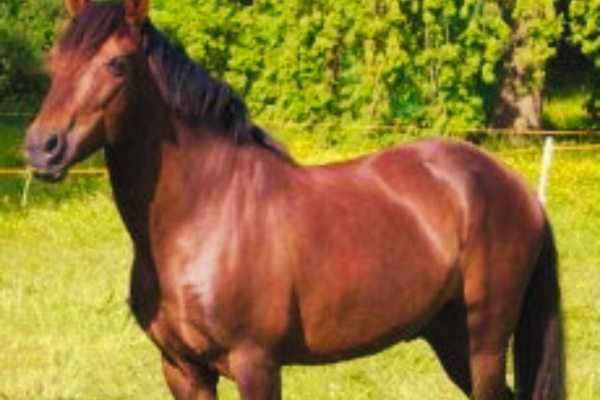The Arravani Horse, an esteemed breed native to Greece, represents a living tapestry of the nation’s equestrian history. Historically pivotal, these horses were extensively employed by ancient Greeks, proving indispensable in transportation and diverse agricultural tasks. Today, their legacy endures as they remain actively engaged in agricultural activities within Greece’s mountainous landscapes, showcasing the breed’s adaptability and continued importance in modern times.
History:
The Arravani Horse has an intriguing past that extends back into ancient Greek landscapes, where its genetic development, cultural significance, and changing roles within Greek society began.
Genetic Evolution and Crossbreeding:
Ancestors from Dorian and Thessalian: At its inception, the Arravani was created through crossbreeding Dorian ponies known for their hardiness with Thessalian horses from Southern Greece known for their grace and speed – creating an unique breed characterized by both strength and agility.
Roman Influence: Over time, Roman horse genes became an essential component of the Arravani’s genetic make-up and were utilized to increase robustness and sure-footedness – two essential characteristics needed to traverse Greece’s various terrains.
Arabian Elegance: Arabian horses imported through Turkish trade routes brought an inimitable style and refinement to the Arravani breed, contributing greatly to their sleek physiques and graceful demeanors.
Cultural and Historical Significance:
Agriculture and Transport Roles: For millennia, Arravani horses were an integral part of Greek rural life, often used by farmers for farming purposes and transportation purposes. Their ability to navigate rugged mountainous paths made them especially advantageous in Greece’s rugged terrain.
Temperament and Adaptability: Arravani horses are known for their calm, gentle demeanor; this trait makes them prized companions in perilous terrain where a calm companionship is essential to safety.
Decline and Current Challenges:
Impact of Modernization: With modern transportation and machinery supplanting their traditional roles, Arravani numbers began to diminish as their relevance in an ever more advanced world declined.
Export and Decreasing Population: The decline was further compounded by selling and exporting horses to Italy for meat production; this trade contributed significantly to their reduced numbers.
Endangered Status: Today, the Arravani Horse faces an uncertain future as their numbers dwindle across Greece – not only signalling their impending disappearance as an important breed but also as part of its rural and cultural legacy.
The Arravani Horse represents an intricate web of history, genetics and cultural importance for Greece. From their ancient beginnings influenced by diverse genetic influences to playing critical roles in Greece’s agriculture and transportation sectors – they have always been deeply interwoven with Greek history.
Unfortunately however, modernity’s challenges have left this noble breed on the brink of extinction necessitating concerted efforts to safeguard their unique presence as part of Greece’s natural and cultural legacy.
Physical Characteristics:
The Arravani Horse stands as an icon of elegance and resilience among equestrian breeds. With its distinctive physical traits that distinguish it as well-suited to meeting various equestrian needs, each aspect of its anatomy contributes to its remarkable adaptability and aesthetic beauty.
Compact and Resilient Hoof Structure:
Hoof Structure: Arravani hooves are noted for being compact yet extremely sturdy – giving this breed its exceptional balance for traversing diverse landscapes with ease.
Elegant and Functional Body Conformation:
Moderate Height with Muscular Build: At 130 to 150 cm in height, Arravani Horses exhibit a delicate balance between size and agility. Horses raised in stables may slightly surpass this range in terms of their physical development due to environmental influences on physical development.
Refined Head and Expressive Eyes: This breed’s head features long and fine proportions with large, expressive eyes that add to its distinct appearance.
Strong Muscular Neck and Torso: The Arravani is blessed with an imposing yet proportionate muscular neck which blends in seamlessly to a well-defined chest and straight back for a powerful physique that exudes harmony and power.
Tail Positioned Appropriately and Inclined Quarters: The high-set tail and inclined quarters of the Arravani contribute to its beautiful silhouette, reflecting strength alongside elegance.
Coat Variety and Color Palette:
Coat Color Variety: Arravani’s can be seen sporting coats in many shades, including grey, black, chestnut, white and dark brown. This wide spectrum of hues not only adds visual interest but also represents their rich genetic diversity within their breed.
Distinctive Gait and Its Suitability for Riding:
Side Trot Proficiency: One of the Arravani’s unique characteristics is their side trot gait, which provides stability and safety, making the breed especially well-suited to western riding or other equestrian disciplines that demand steady and dependable mounts.
Overall, the physical attributes of an Arravani Horse – its solid hooves, muscular build and unique gait – capture the essence of this breed which is both beautiful and functional. Through generations of breeding programs these features have been further refined allowing it to excel at various roles from traversing rugged terrains to competing in equestrian sports while remaining majestic and inviting to look at.

Temperature:
The Arravani horse is known for its welcoming, cooperative nature. This makes them great choices for activities like trail riding, dressage and therapeutic riding programs – both novices and advanced riders can benefit from using them! Their gentle temperament combined with willingness to learn make them suitable companions at every level from beginner riders all the way through to experienced equestrians.
Unfortunately, like many indigenous breeds around the world, Arravani horses have recently faced challenges. Urbanization, changes to agricultural practices, and decreased traditional breeding programs have all contributed to a reduction in population numbers; as a result of these challenges various organizations and local communities have joined together in efforts to preserve this unique breed through breeding programs, public awareness initiatives and cultural tourism events that highlight its heritage and significance.

